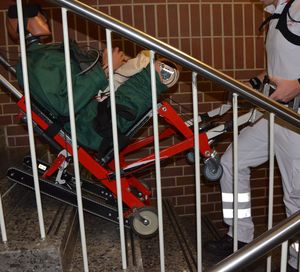KANBrief 4/19

Transporting patients is a physically challenging task for personnel in the ambulance services, particularly when obstacles such as staircases must be overcome. According to the German Ordinance on health and safety requirements for the manual handling of loads at work (pdf, in german) excessive stress, particularly upon the lumbar spine, caused by lifting of heavy loads should be avoided. The question remains however how this can be achieved in practice. A study by the IFA makes important suggestions in this respect.
The transport of patients from their initial location (such as their homes) through to their delivery to a hospital or doctor’s surgery involves several steps. The patient is first transferred to an item of transport equipment, ideally by their own effort. They are then transferred on this equipment to the ambulance, provided the route is unhampered by obstacles. Should however an obstacle such as a staircase have to be overcome, the ambulance service personnel must often carry the transport equipment, the patient, and possibly additional medical equipment. In this situation, the total weight may easily exceed 100 kg, and must generally be carried by only two ambulance service personnel.
Transfer of the patient to the ambulance also generally involves lifting or transferring a large proportion of the total weight. Transporting patients thus involves tasks that often place high physical stress upon the ambulance service personnel. This is reflected in a sickness rate that is higher than that for other occupational groups.
Determining what transport equipment is suitable is not easy. Besides the conventional equipment such as escape chairs and emergency carrying sheets, alternative forms of transport equipment are now available that offer the prospect of relieving the stress upon ambulance service personnel. For a range of reasons, these alternatives have not yet been widely adopted. Obstacles to their use are often ignorance of their existence, or that their effectiveness in relieving the stress has not been studied in detail. Cost factors are a further obstacle to their adoption for the re-equipping or conversion of vehicle fleets. To some degree, the alternative forms of equipment must be regarded as supplements to the conventional equipment, rather than as a replacement for it; this leads to additional weight and a need for more space within the ambulance.
In 2015, the German Social Accident Insurance Institution (DGUV) for the public sector in North Rhine-Westphalia tasked the Institute for Occupational Safety and Health of the DGUV (IFA) with conducting a study (in german) comparing two conventional and two alternative forms of equipment for transporting patients on staircases. The study examined in detail the equipment’s effectiveness in reducing the stress. The study examines transport of a dummy with a weight of 75 kg on a staircase by means of a tracked stair chair or reinforced slide sheet for stair transport, compared to use of a conventional escape chair or emergency carrying sheet. 30 individuals performing the carrying task were fitted with the CUELA measurement system, and also interviewed regarding their subjective perception of the stress. The measurement system recorded the body posture and movement and the action forces arising during the transport process. The physical stress upon the ambulance service personnel, both that measured objectively by biomechanical methods and that perceived subjectively, was shown to be reduced by the use of the alternative equipment. The alternative forms of transport equipment tested therefore represent a worthwhile complement to the existing items of equipment.
A universal form of transport equipment that can satisfy all the requirements under the wide range of conditions of use is however not known to exist at this time. The most suitable item of equipment in a given scenario must therefore be selected from among those available. Databases are one source of information on the available equipment (For example Sicher Rettungsdienst (in german)). Standards (such as EN 1789, Road ambulances) are also intended as a means of recommending items of equipment for reducing the stress upon personnel in the field, and should be consulted during the equipping of new ambulances.
The stress situation of the ambulance service personnel is however not improved merely by the procurement of alternative forms of transport equipment. An available item of equipment must also be suitable for use in the situation concerned, and be used in the correct manner. Regular training is important in this context.
Dr. Christoph Schiefer
christoph.schiefer@dguv.de